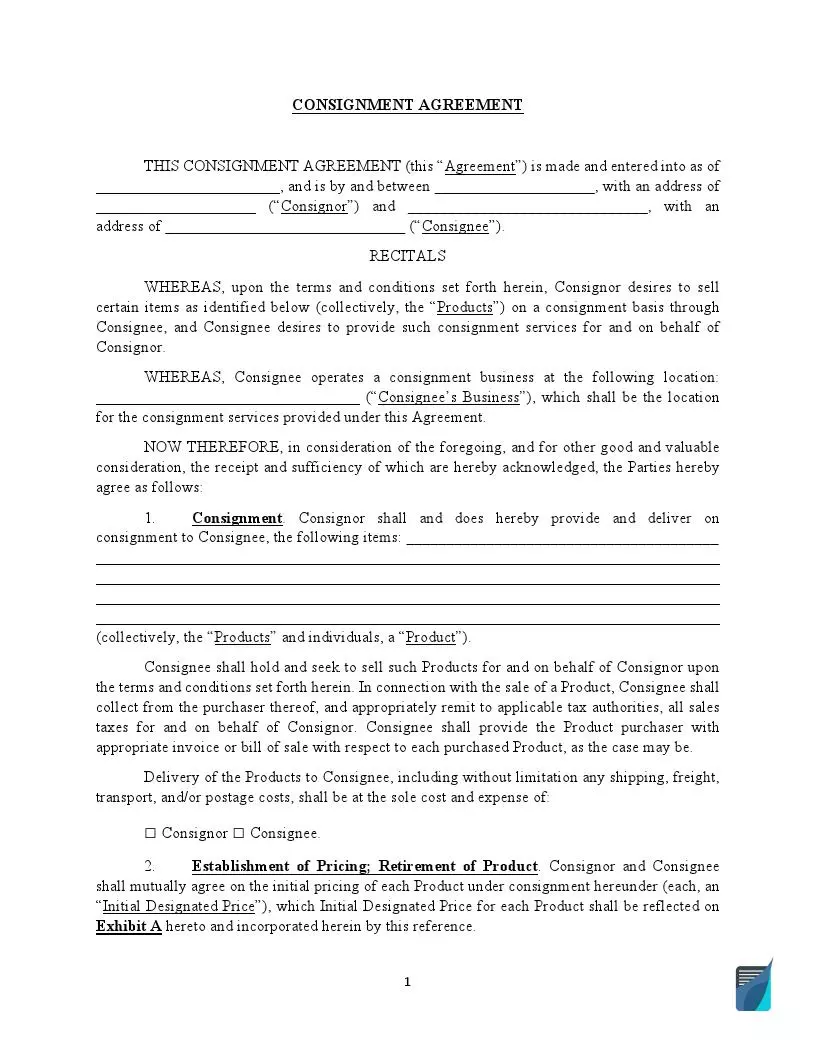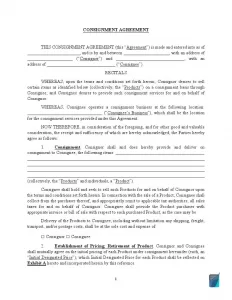Consignment Agreement Template
Here, we will tell you what a consignment agreement is, what information it should cover, and what benefits you will get by creating such a document.

Build Your Document
Answer a few simple questions to make your document in minutes
Save and Print
Save progress and finish on any device, download and print anytime
Sign and Use
Your valid, lawyer-approved document is ready
What is a Consignment Agreement?
When individuals or entities enter into such an agreement, they agree that the seller or manufacturer (that is, consignor) will place their commodities on consignment giving the buyer (that is, consignee) the ability to sell these goods and receive a certain commission.
The consignee agrees to keep the consignor’s goods at a facility or warehouse where the merchandise can be controlled by one of the parties in the contract or a third party. Goods belong to the consignor. The consignee doesn’t take the title and instead acts as an agent who passes the title to those items to a buyer on the consignor’s behalf.
Technically, a consignment agreement lets someone else to sell goods you own on your behalf. The consignee handles the marketing and sales and takes a certain commission for it when you are obtaining most of the sale price with minimal effort.
Types of Consignment Arrangements
There are two types of agreement that allows putting merchandise on consignment:
- exclusive (the consignee becomes the only person who is authorized to sell goods on the consignor’s behalf)
- non-exclusive (the consignee is not the only selling party of the consignor’s goods)
Types of Consignment Merchandise
Items that are most often consigned are clothes and household items. The main difference between a regular store that sells, for example, used clothing and a consignment store is that the first buys clothes directly from manufacturers, becoming the owner of the items, and then resells them, while the second pays manufacturers only once their items are bought.
It is also common to sell vehicles with the use of consignment agreements. For example, a used car can be placed with a dealer to be sold on consignment. The owner of a car keeps the ownership and can also sign a consignment contract with several dealers at a time letting the one who will be the first to sell the car make a deal. It is a good alternative to selling a car to a dealer as in this case, it is usually sold at a price below market value. With a consignment agreement, a vehicle can be offered at a purchase price closer to the market value. This is how the owner of a car can make more, even after paying the consignee’s fee or commission.
Benefits of Consignment Selling
The consignor gets unbeatable benefits when putting their merchandise on consignment:
- The document allows a manufacturer to place their goods in wholesale and retail outlets and get additional exposure to buyers, instead of having it in a warehouse waiting for buyers’ orders.
- It can stimulate wholesalers and retailers to keep goods in stock as their capital is not tied up in stock.
- Wholesalers and retailers can be encouraged to keep seasonal or new merchandise which they may not usually sell due to lack of demand.
- Even after the consignor pays fees or commissions to the consignee, they can get a better price for their goods.

How to Fill Out a Consignment Agreement
A basic consignment agreement includes the following information.
- Information about the parties. It should include details about the consignor and the consignee (names, addresses) and date of the contract.
- Description of the merchandise provided by the consignor.
- Method of pricing, sale price, terms and conditions. The cost can be determined by the consignor, consignee, or both of them. It also applies to setting any discount for the goods.
- Division of the proceeds by parties. It should state the percentage of profit the consignor and the consignee will get.
- Consignee’s payments to the consignor. It should state how much the consignee shall pay to the consignor or manufacturer for every item sold and in what way (company or personal check, money order, cash, etc.) after the consignee’s fees or commission is subtracted. Here, the consignor and consignee should also state how many days the items will be held and displayed.
- Expenses. The provision should state whether there are any expenses the consignee is responsible for.
- Termination of the contract. It should state how many days written notice should be provided by either of the parties if they want to terminate the agreement. Or, there might be a specific date by which the contract terminates.
- Governing laws of the state where agreement takes place.
- Ownership. The clause should include the information about the actual owner of the goods (most often, this is the consignor), the party possessing them, and who bears responsibility for their loss or damage (usually, this is the consignee).
- Merchandise records. Here, it should be clear who is responsible for keeping records in regards to the consignment.
You can easily find a consignment agreement template on the net and use it to write your own contract. But the important thing here is that it should comply with your state laws and completely protect you.
To be confident in getting a legally binding document that will cover all the information needed, use our online document builder. It will help you get an attorney-verified form in just 5 minutes.
Are There Any Disadvantages to a Consignment Agreement?
It depends. For example, one of the disadvantages is that once you enter into a consignment agreement, you will get money only if your items are sold from the shelves of the consignee’s facility. It means that you should have a sufficient amount of cash on hand to wait till you get profit from consignment sales.
You also don’t have a lot of control over the shelving strategy. It might lead to retailers and wholesalers placing their owned inventory in more advantageous places than yours. It is especially relevant if consignees have invested capital in the inventory, and they want to get a fast ROI if your merchandise does not sell well.
The absence of retailers’ investments in the consigner’s merchandise also leads to possible negligence regarding shopper abuse. Some consignees will be putting sales of their own merchandise in the first place, so you, not having any physical control over damages, might not be getting expected profit.
Along with that, sellers might put more effort into the promotion of their own goods.
